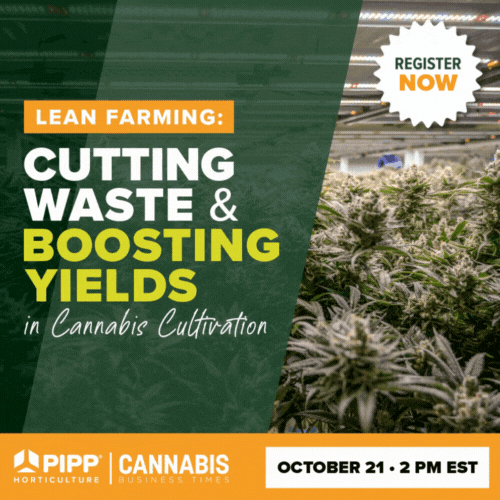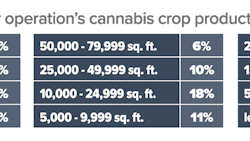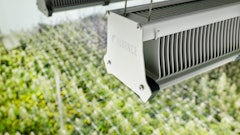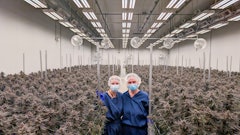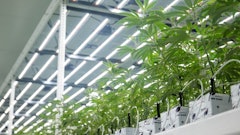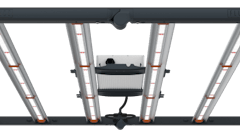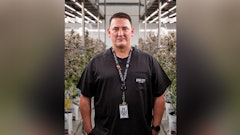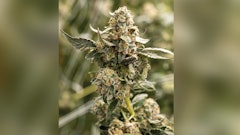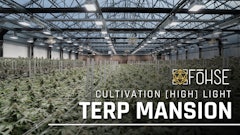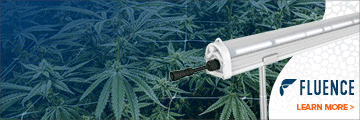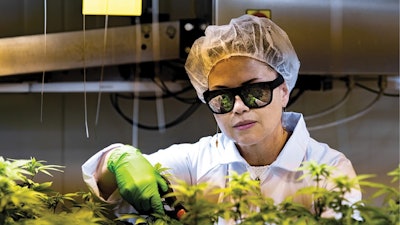
When it comes to cannabis lighting, research in the area generally revolves around two goals: increasing yield and maximizing cannabinoid and terpene content.
As the industry has matured, growers and researchers have seen success with using higher light intensities to increase yield. But manipulating cannabinoid development with lighting remains more of an enigma.
Numerous researchers and lighting companies are studying if and how light spectrum can optimize cannabis’s chemical content. And while results have been mixed, it’s an area of research that shows glimmers of potential.
Adjusting the Light Spectrum
While many studies have demonstrated that higher light intensities proportionally produce higher yields (up to a certain threshold), cannabinoid levels do not respond in the same way, according to Dr. Youbin Zheng, a professor in the school of environmental sciences at University of Guelph. So far, researchers have yet to see cannabinoid concentration increase in proportion to yield as light intensity increases, he says.
Based on research he’s seen, lighting below a certain threshold–roughly 200 micromoles per square meter per second–could reduce the potency of cannabinoids. However, he has not seen higher light intensities increase cannabinoid content.
Researchers have instead turned to spectral quality–i.e., the “color” of the light or, more specifically, the wavelength of the photons hitting the plant–to increase cannabinoid content. But so far, many researchers have yet to see significant effects.
Mitch Westmoreland, a Ph.D. candidate and graduate research assistant at Utah State University in the Department of Plant, Soils and Climate, has two possible explanations for the lack of findings.
“One possible explanation you see very often is there are genetic differences between high-THC cannabis and low-THC cannabis [hemp] in response to spectral quality. … We have been studying low-THC cannabis,” Westmoreland says.
And while they “only differ in a few genes related to cannabinoid synthesis,” and there is little evidence to indicate high-THC and low-THC cannabis respond differently to spectral quality, Westmoreland says, “it’s possible” the higher-THC plants could show different results.
“Everybody who’s worked with this plant knows there’s so much variability from cultivar to cultivar and even within seeds in the same seed lot,” Westmoreland says. “Because there’s so much variability possible, there is the potential for genetic differences in response to spectral quality and light intensity.”
Another possible explanation: many studies so far have been conducted at high light intensities, Westmoreland says, which is good for yield but may inhibit demonstrating what changes in spectrum can actually do.
“Once you reach certain light intensities, the effects of spectral quality [are] much less significant,” Westmoreland says.
He adds that other studies, including one conducted in 2018 and published in the journal “Medical Cannabis and Cannabinoids,” have shown spectral quality can affect cannabinoid production when paired with lower light intensity–around 500 micromoles per meter squared per second.
Therefore, Westmoreland and Zheng agree it is still possible that spectrum can affect cannabinoid content. “However, currently we don’t have enough research to demonstrate what spectrum could be used at what stage,” Zheng says.

The Potential of UVB
For photosynthesis, Westmoreland says plants use light wavelengths from around 400 to 750 nanometers (a range that represents the color spectrum from violet to red).
But plants can detect wavelengths above and below that range, too. And while they cannot use light with wavelengths beyond that range for photosynthesis, they can still capture that light, which could lead to downstream effects as the plant grows.
One particular wavelength that has caught researchers’ attention is UVB (ultraviolet B), which measures around 300 nanometers.
The fascination with UVB likely dates back to research conducted in 1987, which involved exposing both high-THC and low-THC cannabis to UVB light for 40 days, Westmoreland says. The results showed that THC concentration increased in the high-THC variety.
Since then, researchers have attempted to replicate those results with mixed success.
“We did a study where we grew plants at increasing levels of UVB radiation and did not see any effect on cannabinoid concentration, but we did see a really powerful effect of UVB radiation on plant growth and health in general,” Westmoreland says. “UV causes sunburn in humans, and it causes the same thing in plants. UV radiation in our study reduced yield and didn’t significantly affect cannabinoid concentration.”
Zheng and his team had similar results when working with UVB. He offers two theories for the discrepancies between modern findings and the study from 1987.
First, the high-THC cannabis in the original study contained 3% THC. “Nowadays, cannabis has THC content [that ranges from] 20-30%. … You’re looking at different things,” Zheng says. “Probably at that time, UV increased THC because it was so low. I hypothesize that THC can’t increase any more in new cultivars.”
Zheng also theorized that the timing of UV application played a role in cannabinoid development. He and his team tested that theory by applying UVB to plants in the last 45 days before harvest and in the last 20 days before harvest. While they did not see different results, Zheng still doesn’t discount that theory.
“For UV, there is probably more research needed to look at different combos in the future,” Zheng says.
Westmoreland agrees: “I think the next big path that we take in our research is understanding how we can change the light intensity and spectral quality at strategic points in the lifecycle to optimize yield morphology and chemical quality,” Westmoreland says.

Getting the Recipe Right
Timing, varied genetics, different light spectrums and intensities are all factors that could play into increasing cannabinoids and terpenes, making the endeavor a moving target.
But one company that has spent years researching how light affects plants says it has cracked the code.
BioLumic is a company based in the U.S. and New Zealand that uses light to change the genetic expression of crops, including cannabis, to produce specific results. This could include increased yield, drought or pest and disease resistance, and optimized cannabinoid and terpene content.
BioLumic is focused on photomorphogenesis, or light-mediated regulation of plants, rather than photosynthesis. The company’s technology uses one-time, short-duration light signals that activate specific signaling pathways and impact the plant throughout its growth cycle. BioLumic CEO Steve Sibulkin says the technology is all about applying “the right energy at the right time in the right patterns and sequences.”
“We’re basically changing genetic expression with light,” Sibulkin says, adding that BioLumic’s technology is not modifying plants’ DNA. “We’re simply unlocking the natural genetic potential of the plant.”
The technology uses UVB–which, at specific levels, triggers certain responses in plants–along with a mix of other lighting spectrums and intensities to produce certain outcomes, Sibulkin says. The company calls this mixture its “recipes.”
There are trillions of potential recipes that could be applied depending on the cannabis variety and desired outcome, Sibulkin says. One way BioLumic’s technology determines the right recipe is by measuring a plant’s certain proprietary genetic markers.Instead of applying the treatment later on in the lifecycle, Sibulkin says UVB “has the ability early on to influence the direction of how plants will grow.”
“Once you reach certain light intensities, the effects of spectral quality [are] much less significant.” – Mitch Westmoreland, Ph.D. candidate, Utah State University
For cannabis, BioLumic applies its light treatment to cultivators’ clones in the beginning of their growth cycle for six days during the regular propagation cycle. This is enough to produce significant downstream effects, Sibulkin says. After the application, BioLumic continues to track the results throughout the plants’ lifecycles and alters its recipe for subsequent grow cycles if needed.
According to BioLumic Chief Science Officer Dr. Jason Wargent, results when aiming to increase cannabinoid content were promising: When BioLumic treatment was applied to the cultivar White Cheese (which contains around 15% THC and 2% CBD, according to Wikileaf), THC yield per plant increased by 94% and THCA yield per unit of dry flower mass increased by 27%. When the treatment was applied to the cultivar Charlotte’s Angel (which contains around 1% THC and 15% CBD, according to Leafly), CBD increased by 25%, while other minor cannabinoids experienced a significant increase as well.
Setting Goals
Even with gene-detecting technology, “plants are unbelievably multilayered and complex,” Sibulkin says. Using light to produce multiple desired outcomes–i.e. increased yield and cannabinoid content–is even more complicated.
A more realistic target, at least in the short term, is to focus on achieving one specific outcome with lighting.
“There’s sort of this trade-off of, do you want to be able to manipulate cannabinoid and terpene concentration and optimize the chemical quality of the flower, or are you really interested in getting the most yield?” Westmoreland says. “Over the past few years, we’ve found there are differences in how you’re going to light your plant depending on what your goal is.”

